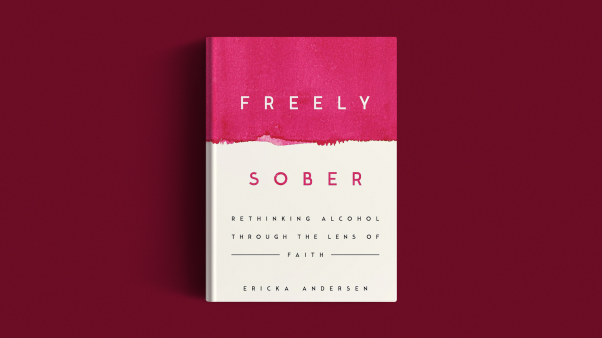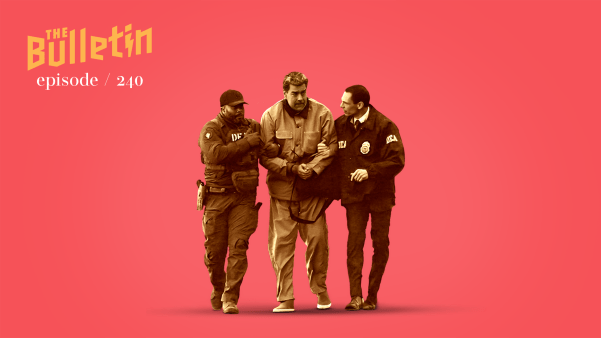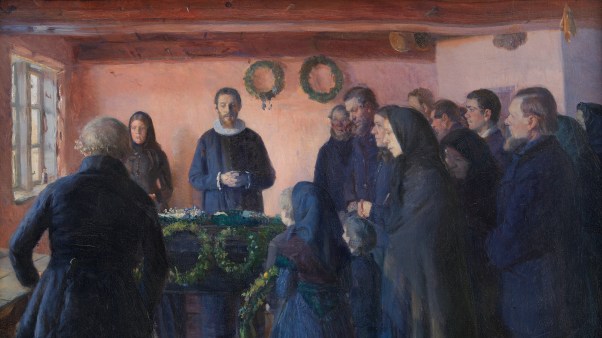Last week, Walter Wangerin Jr. passed away, and a unique voice fell silent. His wife Thanne (short for Ruth Anne), his family, and a few close friends from Valparaiso University were with him when he died.
I first encountered Walter as a speaker at a conference in which we both participated. A slender man with a handsome, angular face and a shock of dark hair, he stalked the stage like a Shakespearean actor. I thought of the accounts of Charles Dickens sitting onstage in the great halls of England, reading his stories to a mesmerized audience.
Yet Wangerin was neither reading nor sitting. He was performing in the purest sense of the word, weaving stories and concepts together in erudite prose, directing our minds and emotions much as a conductor directs an orchestra’s sounds—now meditative and melodic, now electrifying and bombastic.
We got to know each other mainly through the Chrysostom Society, a group comprising 20 or so writers of faith. Walt usually sat quietly on the margins, stroking his then-shaven chin while observing everything around him with piercing blue eyes. He rarely showed emotion, and when he spoke, he acted as a peacemaker, calming the heated arguments that sometimes emerged from the gaggle of writers. A pastor by profession and calling, he seemed thrilled simply to be in the company of writers.
A few years before, he had written The Book of the Dun Cow. At the time, he was trying to support his family on the salary provided by his predominantly African American church, and his days were filled with counseling, parenting, social work, and the many tasks of an inner-city pastor.
To his surprise more than anyone’s, his first book won the National Book Award in the science fiction category, a prestigious award that propelled him into exalted company. The winners in other categories that year included Henry Kissinger, Tom Wolfe, John Irving, William Styron, and Madeleine L’Engle.
Walt and I became fast friends. I had been working in publishing for more than a decade, and he had many questions about the arcane world of editors, agents, and marketing. He wanted only to write, and had just resigned from the church in order to devote himself to the craft full time. I answered dozens of letters of anguish about the pressure he felt from publishers to modify his style. Editors drove him crazy. They urged him to streamline his “heightened prose” and adopt a more pragmatic tone. Walt would listen to their advice, agonize for weeks, and finally decide to ignore it.
No doubt, staying true to his principles cost Walt a broader readership. For example, his book As for Me and My House contains more helpful advice than a dozen others offering “ten steps for a better marriage.”
Yet he rightly refused to accommodate his natural style to the artificiality of self-help bromides. He chose to subsume some of his most powerful personal experiences into The Orphean Passages, knowing that many readers would miss the Greek myth’s overtones. And in private conversations, I heard from him chilling childhood stories that he declined to write about because of the pain it would cause family members.
Walt knew he was swimming against the tide. He spoke of the “cool pragmatism” of modern literary taste. He sought instead to draw the reader into another world, a suspension of disbelief carried more by music and lyricism than by sense and reason. He once told me in a letter that “a writer hopes for the obedience of a good reader who says, ‘I will enter this world a while, however different it is from my own more familiar expressions of truth.’”
Thousands and ultimately millions of readers responded. The late Eugene Peterson, sometimes called “the pastor’s pastor,” credited Wangerin’s first book with helping to clarify his understanding of the pastor’s life. The Book of the Dun Cow, a fantasy novel based loosely on a tale from Geoffrey Chaucer, stars a rooster and a basilisk, along with such supporting characters as a rat, a fox, a toad, and a melancholy dog.
Peterson explained that this unlikely tale diagnoses what’s wrong with modern culture, infected as it is by covert evils that also threaten to undermine the Christian community. Other pastors happily borrowed Wangerin’s stories from Ragman and Miz Lil and The Chronicles of Grace.
Early on, I found myself acting as a kind of guide as Walt confronted the burgeoning evangelical subculture. A lifelong Lutheran, he was accustomed to careful exposition and liturgical worship. I remember when he first heard Tony Campolo speak. He marveled “that a man can be so loud, so funny, and so angry, all at the same time.” Eventually, Walt himself became a prophetic voice to many evangelicals, a popular speaker and frequent interview subject.
Once, we spent a retreat weekend evaluating each other’s manuscripts. We took a break to hike the grounds of a conference center near Colorado Springs and suddenly found ourselves strolling in a meadow where grazed a herd of Rocky Mountain sheep. We stopped walking, so as not to scare them, and stood in silence for a few minutes, watching.
“Want to see a trick?” Walt whispered. “I can whistle at a frequency higher than the human ear can detect.”
I looked at him skeptically. “If I can’t hear it, how will I know?”
“Watch those sheep,” he replied. “I’ll start high and then work down to a frequency you can hear.” He pursed his lips and blew, and not a sound came out that I could detect. Instantly, though, the sheep halted their grazing and lifted their heads toward us, newly alert. A few seconds later, I heard his piercing whistle in a descending scale.
That image has stayed with me, for as I review the shelf full of books written by my friend, I realize that he both heard and wrote in unique ways. I learned to be gentle with my own editorial suggestions for Walt. “The horns of a snail retract at a touch,” he once wrote me. He worried over his books as he worried over his children. Words were to him a sacred offering, given in response to a prompting others did not perceive and sometimes did not understand.
As both a sermonizer and an artist, with graduate degrees in theology and English, Walt lived with the constant tension of how best to express themes of grace and the Cross. As a pastor, he found that story conveys truth most effectively and profoundly. As he told one interviewer, “While the intellect must be addressed in communicating Christian truth, it will not be truth for the hearer until the hearer is also touched deep within himself or herself.”
Although Walt had a mystical, otherworldly side, he nevertheless lived in the mess of human experience. As a child, he endured abuse, including when his mother carried through on a threat to put him in a garbage bag and leave him beside the curb for the garbage truck. A neighbor, who observed squirming motions in the black plastic bag, liberated him.
In academic days, he joined a protest movement that formed a breakaway seminary-in-exile. In his 20s, he led a church congregation with a different racial and social makeup than any he had known. He chaired committee meetings, ministered to street people, negotiated a racially blended family, and taught Bible and literature to cynical undergraduates. On a whim, he bought a farm, where he spent many hours repairing fences, mowing grass, and building a writing retreat reachable only by a trek on wooden planks across muddy fields. Each of these experiences found their way into his self-revealing books.
After the success of his early books, Wangerin was invited to speak on university campuses. He discovered that when he went as a pastor, the left-brained, conceptual approach failed to hold attention. Students assumed he was putting boundaries on reality, not imparting it. On the other hand, when he went as a storyteller, he could function as a kind of priest. “Tell us a story,” they said, and sat down like children. By drawing on his immersion in raw humanity, he could mediate the bewilderment they felt about the adult world they would soon enter.
“If I go as a writer,” he explained, “they assume that I’ve gone through all the torments, all the anguish a prophet should go through and, I mean, I’ve suffered. And not only have I suffered, but I’ve survived in order to write, and I’ve come to some sense of hope, because writing is always putting disorder into order.”
I recently came across one letter that Walt wrote me from Cameroon in 1995. In his vivid prose, he described an appalling sight: two black birds perched on the haunch of a donkey, pecking at an open wound. The African driver of his car yearned for a gun to put the animal out of its misery.
Three days later, returning down the same road, they saw the donkey lying on the ground, now with five birds, their beaks bloody red, pecking away at muscle tissue. Walt despised those birds and pitied the poor donkey—until later he learned the truth. The birds were oxpeckers, born with crimson beaks. Far from hurting the beast, they were cleansing its wound of the maggots breeding there. They were, in fact, saving the donkey’s life. A few days later the donkey was standing again, scarred but alive.
I see a parallel in Wangerin’s work. Some have accused him of writing in a tone of morosity. He wrote of child abuse, and the murderous Saint Julian, and a deluded rooster, and a collapsed Native American culture, and the Passion of Jesus, and The Book of Sorrows. He wrote, in other words, of the reality of our fallen planet in all its brokenness. Truth hurts. Yet it also heals. As a pastor, Walt wrote to heal, to attempt to put disorder into order.
Almost every year, Walt sent me at least one new manuscript or completed book. He authored more than 40 books—including 13 children’s books—as well as books about prayer, marriage, grief, and childhood. He experimented with poetry, plays, sermons, memoirs, a mass, and meditations on Christmas, Easter, and the Passion—oh yes, and also narrative retellings of Jesus, Paul, and the entire Bible.
In his spare time, he taught literature and theology at the University of Evansville and Valparaiso University, penned a weekly newspaper column, and hosted an evening radio show, all while traveling widely as a speaker and helping rear two birth children and two adopted children.
I often wondered at his manic output. And then in January 2006, I received a letter that began,
To tell it to you in story form:
On December 26, while grocery shopping with my granddaughter Cassindra, I reached to touch my neck, just above the left clavicle bone, and found a good-sized mass, some four inches long and deeper under the bone than I could feel. Within two hours, our family physician was examining the mass. … I went almost immediately for both a CAT scan and an X-ray.
Fortunately, all of our children and all of their children were visiting us for Christmas. On Wednesday night of Christmas Week, Thanne and I told our four kids and their sweethearts, darlings, honeys what we had come to know at that point.
Like everything else in Walt’s life, the ordeal with cancer made it into a book, Letters from the Land of Cancer. A biopsy performed on Epiphany revealed metastatic cancer, detected in the lymph nodes but spread from a primary site in his lungs.
His life hung in the balance. Over the next few months, he received the lifetime maximum of radiation, along with chemotherapy five days a week. “I promise you, I am at peace,” he insisted. “We have a wonderful community surrounding us here in Valparaiso, both the town and the University. And my faith, despite so much that I do not know, looks forward to the kingdom.”
In 23 letters, Walt chronicled the stages of his ordeal. The meetings with oncologists. The pain. The surgeries. The sleepless nights. He faced the prospect of death every day. His world shrank. Trips were canceled, and he couldn’t walk a hundred feet without gasping for breath.
I visited Walt at one of the lowest points. He was hairless—“no eyelashes, whiskers, hairs on the backs of my toes, not even in my ears and nose,” he said. He dragged an oxygen cylinder behind him “like an obedient puppy,” in the words of his friend Luci Shaw. Even so, he had to stop every few feet to catch his breath, which seemed to keep running away from him.
He spoke of the losses: missing the premiere of an off-Broadway production of Dun Cow, the ability to sing in church, a recent decision to leave the beloved farm and find a simple house in town. In his immunocompromised state, he had to avoid human touch, even a hug or a handshake.
Meanwhile, Walt studied classics on “the art of dying” and took their wisdom to heart. Lutheran guilt surged up. He had, after all, smoked a pipe for years—could that have precipitated the cancer? Along with many others, I received letters from him apologizing for some slight misunderstanding, wondering what amends he should make.
“I beg God that I might do this thing with grace and gracefully, no matter its length or its ending,” he wrote. “I want to get good at old. Spiritually to approach my losses with the same craft and talent and devotion with which I approach a novel, a poem, a sermon.” He went on to say:
It is often said that once one confronts death, he/she changes, thereafter living every day to the fullest. Every moment becomes its own lifetime. A sort of intense awareness of the present is implied. And I do believe that this happens.
The less time the individual is allowed to presume to follow the present moment, the more important becomes the present moment. The days become, accordingly, more important in themselves.
But however short or long my personal hereafter, a year, a half year, the time present has remained for me what it always was: an opportunity to pay attention.
Pay attention he did. His letters dissect every mood, every jolt of pain or fear, every sign of the changing seasons outside his home.
I saw him just after the chemotherapy—“naked as a baby rat,” in his words— wheezing as he walked me a few yards to my car. “My body is weak, but my mind is fine,” he assured me. Later, he confessed in a letter, “Most of my career I’ve been a breathless kid, rushing things to publication before they were really ready, and now I’m sorry about that. Too messy and too stupid.” He returned to some of his major works and made extensive revisions. He sought to clean up his legacy, with books that yield artistic pleasure as well as joy.
As it happened, Walt lived in the land of cancer for more than 15 years. New books kept appearing under his name. His hair grew back, which he celebrated by letting it grow long, with a grey moustache, beard, and ponytail. He took on the post of writer in residence at Valparaiso. On special occasions, he would conserve energy to deliver an address to an always-packed chapel.
On August 5, after 77 years on earth, his body finally succumbed.
Knowing the man and his story, including parts of it he never published, I want to give him a kind of benediction. I want to say, “Walt, like Saint Julian, like the rooster Chauntecleer, you have been through the silent passage—a time when God was not speaking. You have plumbed the depths, falling to the very bottom. And there you have tasted grace. You have found The Story at the foundation of the universe, that by his wounds we are healed. And you have faithfully and artfully passed it on. Rest content, dear Walter. You have given us a well-crafted life. Because you paid attention, so can we.”
Philip Yancey is the author of numerous books, including the forthcoming Where the Light Fell: A Memoir (Convergent Books, October 2021). Portions of this tribute were adapted from Songs from the Silent Passage: Essays on the Works of Walter Wangerin, Jr. (Rabbit Room Press, 2021). Published with permission.









